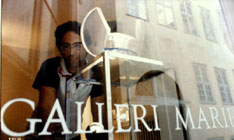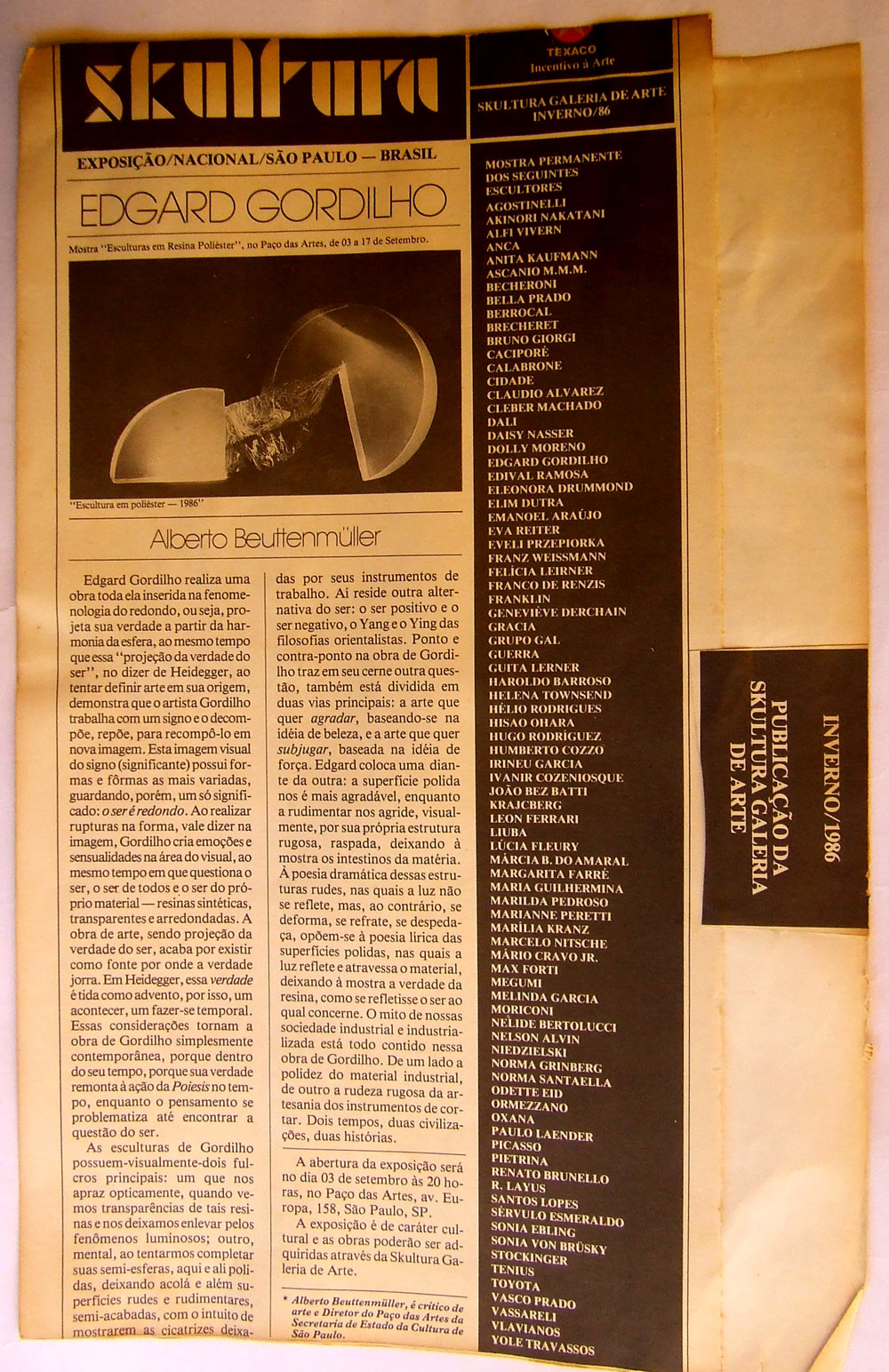esculturas
esculturas destrutivistas
destrutives sculptures
|
esculturas |
esculturas destrutivistas destrutives sculptures |
 |
Det er lykkedes Marius igen at fá en fascinerende udenlandsk kunstner I huse, denne gang fra Brasilien. Nanna Herstad København News / 12/06/86 Marius teve a sorte de ter em sua galeria um fascinante artista estrangeiro, desta vez do Brasil. Lucky Marius had in his galery a fascinating foreign artist, this time from Brazil. |
|
Galleri Marius - Kobenvavn 1986 |
veja cartazes de exposições |
Galeria Aktuell Rio de Janeiro 1985 |
Paço das Artes São Paulo 1986 |
 |
 |
 |
 |
 |
|
Este lote de trabalhos possui um rigor de linguagem, mobiliza um esquema de signos ( e, conseqüentemente, cobra do espectador um nível de exigência ) dos mais altos. Aqui ele rompe o círculo como procedimento formalmente caracterizador. E, metaforicamente, romper com o círculo é romper com toda semiologia que aponta para o estável, para o perfeito, para o coerente. Semiologia que está no anel de jade dos imperadores chineses, no anel lançado às águas na investidura de cada doge veneziano, no anel que é partido quando morre o papa que o possuiu. Opostos a essa circularidade ordenadora, que nos domínios da arte logo descamba para o repetitivo, outro são os caminhos desse jovem escultor, cuja intimidade com sua matéria prima o leva a não apenas conceber suas formas, mas também a executá-las. E este último ato imprime ao processo um caracter oficinal - no sentido renascentista do termo - que muito lhes acrescenta em inventiva e minúcia. Inventiva e minúcia que são respostas, na forma de achados e soluções, a cada dificuldade inerente à própria tecnologia das resinas. E o são também, num plano mais alto, às perigosas armadilhas de que está povoado o reino da representação tridimensional, tão próximo ao kitsch e ao déjà vu. E esse fazer instaura sua propria semiologia, oposta às concepções pitagóricas e alquímica do círculo, que é essa ambigüidade de graças e rusticidades. Ambigüidade que depõe contra o próprio processo, perfazendo ( talvez sem que disso o artista mesmo se dê conta ) outro círculo, que é o do objeto questionador do seu próprio sujeito. Arestas agressivas e curvas sensuais; transparências cantantes e surdas opacidades; levezas e contundências - tais são os jogos que Edgard Gordilho propõe e menos, certamente, à nossa avidez pela forma, enquanto coisa gratificante, que à nossa capacidade intelectual de decompor e recompor, à nossa sensibilidade de empatizar e entropizar. Tais as fascinantes leituras de uma obra materialmente austera, mas nem por isso menos rica em termos de instigação. De umaobra otimamente resolvida do ponto de vista técnico; onde, porém, não se lê, em nenhum instante, a frieza do artefato. De uma obra ambiciosa em termos de inserção estética, mas nada vizinha das equivocadas matafísicas que tanto seduzem e comprometem a forma tridimensional nos dias de hoje, no mundo inteiro. Passada em julgado na instância internacional (mostras de Paris, Copenhague e Lisboa) a obra de Gordilho nos dá agora a ler o mais denso e também o mais conciso dos capítulos de sua continua ascenção. Rui Sampaio apresentação de catálogo / maio 1985 |
Edgard Gordilho realiza uma obra toda ela inserida na fenomenologia do redondo, ou seja, projeta sua verdade a partir da harmonia da esfera, ao mesmo tempo que essa "projeção da verdade do ser", no dizer de Heidegger ao tentar definir arte em sua origem, demonstra que o artista Gordilho trabalha com um signo e o decompõe, repõe, para recompô-lo em nova imagem. Esta imagem do signo (significante) possui formas e fôrmas as mais variadas, quardando, porém, um só significado: o ser é redondo. Ao realizar rupturas na forma, vale dizer na imagem, Gordilho cria emoções e sensualidades na área do visual, ao mesmo tempo em que questiona o ser, o ser de todos e o ser do próprio material - resinas sitéticas transparentes e arredondadas. A o bra de arte, sendo projeção da verdade do ser, acaba por existir como fonte por onde a verdade jorra. Em Heidegger, essa verdade é tida como advento, por isso, um acontecer, um fazer temporal. Essas considerações tornam a obra de Gordilho simplesmente contemporânea, porque dentro do seu tempo, porque sua verdade remonta à ação da Poeisis no tempo, enquanto o pensamento se problematiza até encontrar a questão do ser. As esculturas de Gordilho possuem - visualmente - dois fulcros principais: um que nos apraz opticamente, quando vemos transparências de tais resinas e nos deixamos enlevar pelos fenômenos luminosos; outro, mental, ai tentyarmos completar suas semi-esferas, aqui e ali poidas, deixando acolá e além superfícies rudes e rudimentares, semi-acabadas, com o intuito de mostrarem as cicatrizes deixadas por seus instrumentos de trabalho. Aí reside outra alternativa do se: o ser positivo e o ser negativo, o Yang e o Ying das filosofias orientalistas. Ponto e contra-ponto na obra de Gordilho traz em seu cerne outra questão, também esta dividida em duas vias principais: a arte que quer agradar baseando-se na idéia de beleza, e a arte que quer subjulgar, baseada na idéia de força. Edgard coloca uma diante da outra: a superfície polida nos é mais agradável, enquanto a rudimentar nos agride, visualmente, por sua própria estrutura, raspada, deixando à mostra os intestinos da matéria. À poesia dramática dessas estruturas rudes, nas quais a luz não se reflete, mas ao contrário, se deforma, se refrate, se despedaça, opõem-seà poesia lírica das superfícies polidas, nas quais a luz reflete e atravessa o material, deixando à mostra a verdade da resina, como se refletisse o ser ao qual concerne. O mito de nossas sociedades industrial e industrializada está todo contido nessa obra de Gordilho. De um lado a polidez rugosa da artesania dos instrumentos de cortar. Dois tempos, duas civilizações, duas histórias. Alberto Beuttenmuller apresentação de catálogo / 1986
|
This batch of his work has a rigorous language, mobilizes a scheme of signs and, consequently requires trom the viewer a very high level. Here he breaks the circle as a formally characterizyng proceeding. And methaphorically, breaking the circle is to break with e whole semiology that points to the stable, to the perfect, to the coherent. Semiology that is in the ring of jade of chineses emperors, in the ring thrown in the water at the investiture of each venetian doge, in the ring that is shattered when the pope whi owns it dies. As opposed to this orderly circularity, while in art quickly becames repetitive - others are the ways of this yong sculptor, whose intimacy with his raw-material makes him produces his forms, and not just conceive them. This gives the procedure a aspect of craftin the renaissance meaning of the term - which enhaces the inventiveness and the minute details. Investiveness and detail that are answers, in form of findings and solutions, to each difficulty inherent to the resin's technology. And also, at a higher level, to the dangerous traps that fill the kingdom tridimensional representation, very close to kitsch and to the déjà vu. And this way of doing establishes its own semiology, as opposed to the pythagoric and alchemical concepts of the circle, this ambiguity of grace and rusticity. Ambiguity that testifies about its own process, concluding (maybe without the artist knowledge) another circle, that belongs to the object questioning its own subject. Aggressive edges and sensuous curves; musical transparencies and soundless opacity; lightness and aggressiveness - such are the games that Edghard Gordilho proposes. Such are the fascining readings of e materially austere work, but not for that less rich in terms of instigation. Very well resolved work from the techinical point of view; nonetheless, at no time, one feels the coldness of artifact. The coldness of an ambitious work in therms of aesthetic insertion, but not close to the mistaken metaphysics, wich seduces and compromise so much the tridimensional form in our time, all over the word. Having been judged at the international level (shows in Paris, Kopenhagen and Lisabon), Gordilho's work allows us now the densest and the most concise reading of the chapter of his continuous growth. Rui Sampaio |
Edgard Gordilho carriers out all his work of art insert in the phenomenology of the round, or better, projects his truth accordilng to the sphere's harmony, at the same time that this "projection of the truth of being", as said by Heidegger, whem trying to define art in ti's origin, demonstrates that the artist Gordilho, works whith a sign and decomposes it, puts it toguether again to recompose in a new image. This visual image of the sign (significant) has all sorts of shapes and moulds, treasuring though, only one meaning: the being is round. While making ruptures in the shape, that is the image, Gordilho creates emotions and sensuality in the visual area, at the same time that he questions the being, the being of everyone and the being of the material - syntetic resin, transparent and with round shapes. The work of art, being the projection of the truth of being, ends by existing like the fountain from where the truth pours. In Heidegger, this truth is said to be like an advent, therefore, a happening, a temporal do. These considerations make Gordilho's work simply contemporany, because it's in his time, because his truth returns to the action of Poesis in time, while the mind tries to figure out the question of being. Gordilho's sculptures have visually two fulcrums: one that pleases us optically, when we see transparencies of such resins and let us selves enrapturated by the luminous phenomenon; other, mental while we try to complete it's hemisphere, polished here and there, leaving rough and rudimental surfaces there and beyond, semi-finished, with the intent to show the scars left by his work instruments. There reigns another alternative of the being: the positive being and the negative being, the Yang and Ying from the oriental philosophies. Point and counterpoint in Gordilho's work brings in his core another question, wich is also divided in two main vias: the art that wants to please, based on the idea of bealty, and the art that wants to subjugate, based on the idea of strength. When we put facing each other the polished surface is nice to us, while the rudimental attacks us visualy, for it's own rugose structure, scratched, leaving guts to be seen. The dramatic poetry of these rough strictures, in which light does not reflects, but, on the contrary, refracts, shalters and opposes to the lyric of the polished surface, in which the light reflects and passes through the material, leaving to be seen the truth of the resin, as if it were reflecting the being which is concerned. The myth of our industrials and industrialized society is all insert Gordilho's work. In one side the polished of the industrial material, in the other the rugose roughness of the artesian instruments used for cutting. Two times, two civilizations, two histories. Alberto Beuttenmuller
|


veja outras reportagens publicadas
| esculturas
concretas concretes sculptures |